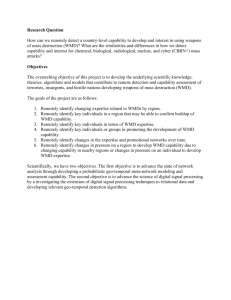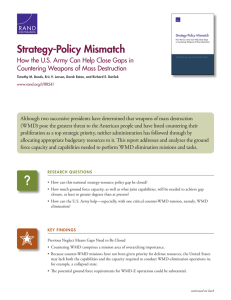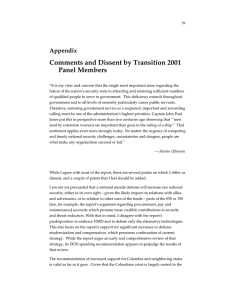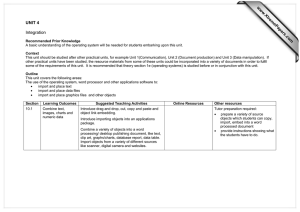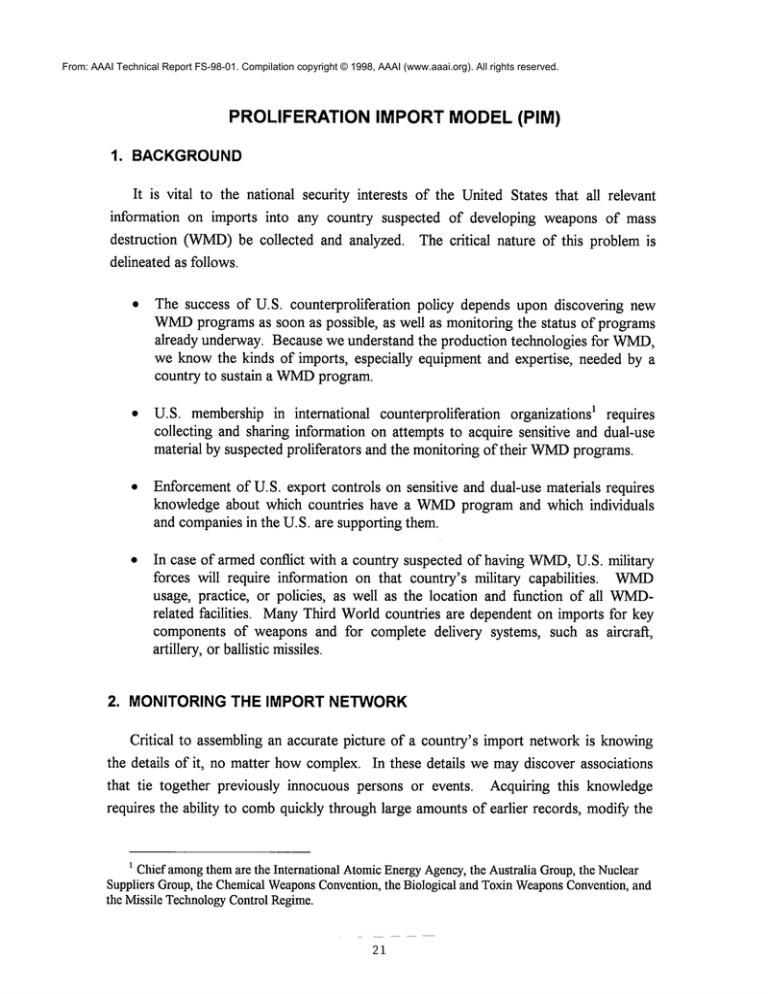
From: AAAI Technical Report FS-98-01. Compilation copyright © 1998, AAAI (www.aaai.org). All rights reserved.
PROLIFERATION
IMPORT MODEL (PIM)
BACKGROUND
=
It is vital to the national security interests of the United States that all relevant
information on imports into any country suspected of developing weapons of mass
destruction (WMD)
be collected and analyzed. The critical nature of this problem
delineated as follows.
The success of U.S. counterproliferation policy depends upon discovering new
WMD
programs as soon as possible, as well as monitoring the status of programs
already underway. Because we understand the production technologies for WMD,
we knowthe kinds of imports, especially equipment and expertise, needed by a
country to sustain a WMD
program.
U.S. membershipin international counterproliferation organizations 1 requires
collecting and sharing information on attempts to acquire sensitive and dual-use
material by suspected proliferators and the monitoring of their WMD
programs.
Enforcementof U.S. export controls on sensitive and dual-use materials requires
knowledge about which countries have a WMD
program and which individuals
and companiesin the U.S. are supporting them.
In case of armedconflict with a country suspected of having WMD,
U.S. military
forces will require information on that country’s military capabilities. WMD
usage, practice, or policies, as well as the location and function of all WMDrelated facilities. ManyThird Worldcountries are dependent on imports for key
components of weapons and for complete delivery systems, such as aircraft,
artillery, or ballistic missiles.
2. MONITORING THE IMPORT NETWORK
Critical to assembling an accurate picture of a country’s import network is knowing
the details of it, no matter howcomplex. In these details we maydiscover associations
that tie together previously innocuous persons or events. Acquiring this knowledge
requires the ability to combquickly through large amountsof earlier records, modifythe
Chiefamong
themare the InternationalAtomicEnergyAgency,the AustraliaGroup,the Nuclear
SuppliersGroup,the ChemicalWeapons
Convention,
the Biologicaland ToxinWeapons
Convention,and
the MissileTechnology
ControlRegime.
21
previous structure of an import network, and update our collection requirements
accordingly. Automatingpart of this process could improve collection strategies while
decreasing both cost and processing time.
With just a partial picture of an import network assembled, we can begin monitoring
daily activity on an import network to determine underlying patterns, indicators of new
activity, and methodsof carrying out and disguising transactions. Wecan also start to
"inventory" imported goods. Through daily monitoring we should also gather enough
information to support interdiction,
which poses the most demanding tasks on
information. It not only requires highly reliable details on persons, places, and timing, but
it must be collected and analyzed quickly enough to be acted upon. A systematic means
for optimally identifying and analyzing interdiction targets in the import network will
enhancetimelines and the success rate of such operations.
3. THE IMPORT PROCESS
Even simple import transactions
can take several steps and provide numerous
opportunities for concealment. The ultimate customer may deal with one or more
intermediaries, whomaybe either wholesalers or front companies. If the customer is a
government agency, such as a ministry of defense, a purchase maygo through another
agency or a government-ownedbusiness.
Theintermediaries, in turn, act through a purchasingagent, whomaybe in yet another
company. The purchasing agent could work with one or more banks or financial
institutions to arrange financing for the purchase. If the purchasingagent worksthrough a
broker, there would be still another set of finance, documentation, and personal
interactions.
The purchasing agent or broker wouldthen contact a supplier or a sales agent for the
supplier, whocould be unawareof the ultimate end user. If the desired product is not in
inventory or must be custom made, the supplier mayhave to order raw materials of
components,introducing another series of events and cast of characters.
After a critical product is ready for shipment, the purchaser maydevise a convoluted
itinerary consisting of numerousdestinations or modesof transportation. The apparent
final destination mayturn out to be a diversionary companyor an intermediary country.
As this process illustrates, there are countless avenuesopento a proliferant seeking to
thwart discovery of WMD-relatedimports. Transactions becomemore complicated, front
organizations are established, goodsare relabeled, false documentsare passed, circuitous
22
transport routes are employed,covert shipping is utilized, and sometimesthere is outfight
purchase of foreign supplier companies.
4. THE PROLIFERATION IMPORT MODEL(PIM)
4.1
ADVANTAGES
As discussed above, the sources of data on WMD
imports are diverse, voluminous,
and complex. Proliferation analysts need systematic procedures and automated tools to
help them contend with these problems. PIMis an automatedtool that:
¯
Conveniently displays graphs portraying suppliers and routes for imported WMD
commodities.
¯
Estimates the status (e.g., size and completeness)of the import networkfor each
proliferant.
Quicklyupdates the status of imports as newintelligence data becomesavailable.
Pinpoints knowledgeand collectability gaps, and highlight potential vulnerabilities
in the import network.
Evaluates the impact of interdiction at key nodes in the import network.
Finds points of convergence and divergence
different countries with respect to imports.
among the WMD
programs of
Finds the most likely suppliers and routes in the import network.
Interacts seamlessly with network models of WMD
production to provide end-toend coverage of a WMD
program.
PIM currently is in the form of proof-of-concept software designed with a view
toward eventual integration with the indigenous WMD
production models CWCAP
and
NCAP(Chemical Weapons and Nuclear Capabilities
Acquisition Process models,
respectively). Integration with the CAPmodels would result in an end-to-end WMD
23
procurement network model that would conveniently associate PIMimport networks with
countries in the CAPdatabases, as well as the critical commoditiesin those country’s
procurementpaths.
4.2.
METHODOLOGY
While the concept of extending proliferation path analysis to import networks was
motivated by the CAPmodels, critical differences between CAPand PIM obviate the
sharing of theory or software. Mostnotable, CAPmodelsuse a tree structure or template
to represent time sequenced production activities while the PIMgraph represents the
physical shipment of WMD
commodities. CAPnodes ("and," "or," etc.) are logical
devices for procurement actions, while PIMnodes represent suppliers, transshipment
points or destinations. Production activity occurs along CAPbranches while PIMarcs
represent shipping routes. In short, procurementpaths in the CAPtemplate are analogous
to a PERTchart while the PIMgraph resembles that used for networkflow analysis.
The design of PIMis driven by the intended use of the model and the nature of the
data it must accommodate.The overall goal is to provide a fast, flexible, graphically
based tool for assessing the status of WMD
imports for a given country. However,the
enormoussize and complexity of suspect or feasible routes suggests that displaying the
entire network for even a single commodityis doomedto failure. For the proof-ofconcept model, we designed and implemented a method that accepts detailed data on
suspect and feasible routes while providing the user with a compressednetwork suitable
for viewing on a computer monitor. In future versions, parts of the compressednetwork
maybe expandedto explore activity within a selected country or betweencountries.
4.3
DATA
PIMprovides a systematic meansto input, store, analyze, and display complexand
voluminousdata on the importation of critical WMD-relatedcommodities. It focuses on
the physical routing of commoditiesas established by analysis of detailed data on isolated
legs (or arcs) of the network. Whileit is not necessary to provide data such as individual
transactions and associated purchase orders and financing, etc., a link analysis module
capable of exploiting such information (when available) could further expand suspect
networks.
Minimaldata for each arc in the import networkis the estimated probability, /3/j, that
a route from node i to nodej is being used, or is planned for use, in a country’s network
24
for procurement of a given commodity. Clearly, ,b/j is established from analysis of
detailed data, either open-source or classified. In manycases, evidence of current or
future use is lacking so that /3/j -- 0 in these cases. Arcs for which/3/j > 0 are termed
suspect arcs and, since evidence is generally sparse, suspect arcs maybe relatively
isolated. To tie together these suspect subnetworksthe user also must enter eo(i,j) the
estimated effort required to implementa shipping route from country i to countryj.
It is convenientto think of eo in terms of"cost" to the proliferant on a log scale. For
example,if it costs $1,000,000to establish and implementthe capability to ship a nuclear
.
[- cost q
trigger fromcountryi to countryj, then eo(i,j)= logl0[~i-~0-~J= log10
[l~x103106
= 3.
Wedivide by $1,000 so that a one on our effort scale corresponds to a reasonable
minimumcost.
Of course, there are manyfactors other monetary cost that enter into the effort
required to setup a WMD
import network including such intangibles as risk of discovery.
The purpose of trying to capture the effort required by a simple quantitative measureis
that we maylink individual parts of the network for which we have evidence so that
supplier-to-destination paths maybe evaluated even whenincomplete.
For example, if we have evidence that fissile material which maybe bound for
Baghdadhas madeit to Damascus,we would clearly require a meansto demonstrate that
the final routing to Baghdadis relatively easy, even in absenceof informationon that final
leg. This case must be distinguished from the one where our evidence only tracks the
fissile material as far as Munich,in whichcase considerable effort remainsto completethe
routing to Baghdadcalling into question the ultimate designation of the material. The
interplay betweensuspect arcs and nodes (i.e., those for whichwe have evidence) and the
effort required to completethe networkis the foundation of the P/Mmethodology.
5. LINK ANALYSIS
The PIM proof-of-concept sot~ware has focused on the physical flow of WMD
commodities from supplier to destination. Specifically, we have demonstrated that an
import network can be constructed and analyzed from sparse, inconsistent data. In the
future, we hope to use the physical networkas the basis for developing the transactional
network (i.e.,
activities.
communications, purchasing, financing, etc.) underlying importation
25
Link Analysis (LA) is a methodologythat can create and display associations between
organizations and individuals in say, a drug cartel. WhileLAis well suited to address the
simplest questions (e.g., is there a link betweenperson Aand person B?), it generally does
not disclose an organization’s structure or activity. In addition, LAgraphic displays can
get overloadedwith links.
Our approach to the use of LAaddresses these difficulties by using the PIMnetwork
as the hierarchical structure for import activities and analyzing links in the background
using qualitative attributes to draw associations amongsuspect arcs and nodes. In this
manner for example, the presence of an organization knownin one instance to support
WMD
importation could increase the use probability (/3) of an otherwise non-suspect arc
or node. Similarly, the presence of associates of knownWMD
facilitators could likewise
implicate other parts of a potential import network.
Just as these association can increase /3 for various arcs and nodes in the network,
removal or neutralization of key organization or individuals can decrease /3. Since a
decrease in /3 for the affected portions of the network translates into lower path
probabilities,
we have a mechanismto evaluate counterproliferation
overt interdiction of commodities.
26
strategies beyond


